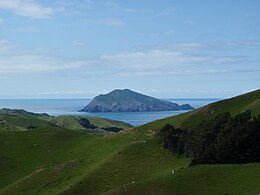Stephens Island, New Zealand
| Takapourewa (Māori) | |
|---|---|

Stephens Island as seen from D'Urville Island
|
|
| Geography | |
| Location | Marlborough Sounds |
| Coordinates | 40°40′S 174°00′E / 40.667°S 174.000°E |
| Area | 1.5 km2 (0.58 sq mi) |
| Highest elevation | 283 m (928 ft) |
| Administration | |
| Demographics | |
| Population | 0 |
Stephens Island is at the northernmost tip of the Marlborough Sounds in the South Island of New Zealand. It lies two kilometres to the northeast of Cape Stephens, the northernmost point of D'Urville Island. The Māori call the island Takapourewa but Stephens Island is the commonly used name. The island is 1.5 square kilometres (0.58 square miles) in size, and rises 283 metres (928 ft) high from the sea.
The island featured in local mythos as the place where a local lighthouse keeper's cat, named Tibbles, was claimed to have caused the extinction of Lyall's wren in 1894. However, this belief was erroneous, an urban legend. While this cat did kill one of the last birds seen, a few more specimens were obtained in the following years, by which time the island also hosted numerous feral cats, and the island was only the last refuge of the bird, which had become extinct on the mainland many centuries earlier due to Polynesian rat predation.
Today, the best known residents of Stephens Island are the tuatara. The island is a sanctuary for this rare type of reptile which is now extinct on the mainland, except in tightly controlled reserves including ecological islands.
Stephens Island is internationally important for nature conservation. While most attention has focused on tuatara, the significant and unique factors include:
In natural character, Stephens Island is a rugged landmass dominated by maritime influences. Visually the island is connected to the adjacent larger D’Urville Island, and Stephens Island is the largest of the family of islands, islets and rock stacks that characterise this southwestern side of the Cook Strait. Although uninhabited, the island has been extensively modified by land clearance and farming, but retains much of its wild natural character. From sea level the lighthouse is a prominent visual feature, while from the air the cluster of buildings and farmed landscape are obvious.
...
Wikipedia
